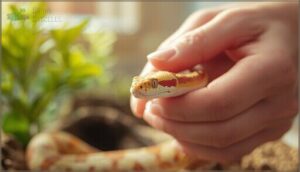This site is supported by our readers. We may earn a commission, at no cost to you, if you purchase through links.
Your new snake coils around your arm for the first time, and suddenly you’re responsible for keeping a reptile alive—no second chances, no room for guesswork. Unlike dogs or cats that make their needs obvious, snakes communicate through subtle shifts in behavior that inexperienced owners often miss until it’s too late.
Proper snake care isn’t complicated, but it demands precision: the wrong temperature by five degrees, a missed feeding cue, or a dirty water bowl can spiral into serious health problems within days. The difference between a thriving snake and a struggling one comes down to understanding what your species needs and delivering it consistently, week after week, for the next 20 years.
Table Of Contents
- Key Takeaways
- Choosing The Right Pet Snake
- Setting Up a Safe Snake Enclosure
- Feeding and Nutrition for Snakes
- Cleaning and Maintenance Essentials
- Monitoring Snake Health and Behavior
- Frequently Asked Questions (FAQs)
- Are snakes easy to care for?
- How to take care of a snake for beginners?
- What does a snake need in its cage?
- How do I keep my snake happy?
- How do you take care of a snake?
- How to care for a snake in a natatorium?
- How do you handle a pet snake?
- How often should I clean my snakes water dish?
- Can snakes recognize individual humans by scent?
- Is it safe to house multiple snakes together?
- Conclusion
Key Takeaways
- Snake care demands precision in temperature control, humidity levels, and feeding schedules—mistakes of just five degrees or a few days can trigger serious health problems that escalate quickly.
- Beginner-friendly species like ball pythons and corn snakes tolerate handling well and forgive minor errors, but all snakes require 20-30 year commitments with consistent daily maintenance taking only minutes.
- Proper enclosure setup with secure lids, thermal gradients (75-92°F), species-appropriate humidity (40-85%), and multiple hides prevents most health issues before they start.
- Daily spot cleaning, fresh water changes, and careful observation of shedding cycles, feeding responses, and respiratory signs catch problems early when they’re still fixable.
Choosing The Right Pet Snake
Your first snake should be one you can care for confidently from day one. Some species tolerate beginner mistakes better than others, while certain snakes demand years of experience to keep healthy.
Before you bring a snake home, you need to understand what you’re signing up for regarding size, lifespan, and how much handling they’ll tolerate.
Popular Beginner-Friendly Species
If you’re new to snake care, start with species known for calm snake behavior and straightforward pet snake needs. Ball pythons top most beginner tips lists—they’re docile and handle stress well. Corn snakes adapt easily to varied setups, making them another solid choice. California kingsnakes tolerate handling without fuss. Rosy boas stay small and forgiving.
When comparing species, consult a reputable snake breeder who understands your experience level and can guide your decision. For learning more about specific words, check the language reference tools available online.
Size and Lifespan Considerations
Size and lifespan matter more than you might think. Corn snakes reach 3–5 feet and live 10–20 years, while ball pythons hit similar lengths but often surpass 20–30 years.
Your pet snake enclosure will need upgrading as growth happens—most reach adult size in 2–3 years. Plan for reptile care spanning decades. This longevity commitment shapes your housing budget, travel flexibility, and long-term snake behavior observations. Choose wisely from the start.
Understanding ball python facts is vital for making informed decisions about pet snake care.
Temperament and Handling Needs
Beyond size and years, temperament shapes your daily snake care experience. Ball pythons curl defensively rather than strike, earning their reputation as docile pets. Corn snakes stay calm during handling and tolerate beginner mistakes better. Both species rank high for predictable reptile behavior.
Key handling tips to reduce stress management challenges:
Finding a qualified reptile veterinarian in your area makes it easier to address health concerns quickly and confidently.
- Start with brief, calm sessions after your pet snake settles in
- Support the body fully—never grab the head
- Watch for hissing or rapid tongue flicks signaling discomfort
- Skip handling right after feeding to prevent regurgitation
- Wash hands before and after every interaction
Socialization techniques matter. Research shows handling itself triggers measurable stress, even when snake behavior looks normal. Keep sessions short and purposeful rather than frequent. Temperament tests aren’t formal, but observing feeding response and defensiveness helps predict handling needs. Understanding reptile behavior and biology means recognizing that your snake’s calm appearance doesn’t always reflect internal comfort—moderation protects long-term well-being in snake behavior and psychology.
Proper feeding schedules and prey sizing are just as important as handling frequency—both play into your snake’s overall stress levels and health, which you can explore further in this comprehensive corn snake care guide.
Setting Up a Safe Snake Enclosure
Your snake’s enclosure is the foundation of everything—get it right, and you’ve solved half the puzzle before you even bring your new pet home.
A proper setup isn’t just about buying a tank and calling it done. You need to think about size, security, temperature control, and giving your snake places to hide and feel safe.
Terrarium Size and Secure Lids
Your snake enclosure needs room to move—adult corn snakes require at least 48 by 24 by 24 inches, while ball pythons thrive in a 4-by-2-by-2-foot terrarium.
Beyond space, you’ll need to plan feeding routines carefully—check out this complete pet snake feeding guide to match meal frequency with your snake’s age and species.
Secure lids with at least four clamps prevent escapes, since snakes flatten their bodies to slip through tiny gaps. Front-opening designs with locks work best for handling.
Cover three glass walls to reduce stress and discourage escape attempts along transparent surfaces.
Heating, Lighting, and Humidity Control
Proper temperature gradients let your snake thermoregulate naturally: create a cool side around 75–82°F and a warm basking spot at 88–92°F using heat mats or heat lamps. Always connect your heat sources to a thermostat to prevent burns and maintain precise temperature control. Most snakes don’t require UVB, though a 6% UVB tube promotes immune health.
Humidity levels vary by species:
- Corn snakes thrive at 40–50% relative humidity
- Ball pythons need 65–85% for healthy shedding
- Monitor both zones with digital hygrometers
- Use humid hides for localized moisture
- Replace UVB bulbs every 6–12 months
Substrate, Hides, and Enrichment
Your choice of reptile substrate directly affects humidity control and respiratory health. Cypress mulch holds moisture well for ball pythons, while aspen shavings suit corn snakes with better airflow. Reptile carpet prevents accidental ingestion. Place opaque hides on both thermal gradients—warm and cool zones—so your snake can regulate body temperature while feeling secure.
| Substrate Options | Best For |
|---|---|
| Cypress mulch | Humidity-loving species (ball pythons) |
| Aspen shavings | Dry-climate species (corn snakes) |
| Reptile carpet | Easy cleanup, impaction prevention |
| Paper-based | Budget-friendly, frequent changes |
Enrichment strategies like branches, cork bark, and rotating decor encourage natural exploration and reduce stress in reptile husbandry. Proper habitat creation fosters long-term snake care and well-being.
Feeding and Nutrition for Snakes
Feeding your snake the right food keeps it healthy and strong. You’ll need to understand what prey to offer, how often to feed, and how to do it safely.
Let’s cover the essentials of snake nutrition and feeding practices.
Types of Prey and Proper Prey Size
Most pet snakes thrive on rodents—mice and rats are the go-to for typical constrictors and colubrids. Frozen-thawed prey beats live options because it won’t bite back or injure your snake. Aim for prey about equal to your snake’s widest body part, or roughly 1 to 1.5 times that diameter.
- Hatchlings start on tiny pinkies and move up as they grow
- Adults handle larger mice or small rats every week or two
- Specialists like hognose snakes may need amphibians or scented prey
- Oversized meals account for around 40% of feeding-related deaths
Feeding Frequency and Safe Techniques
You’ll feed young snakes every five to seven days, while adults do fine on ten- to fourteen-day intervals.
Always thaw frozen rodents completely—pop them in warm water for ten to fifteen minutes—so your pet snake digests properly. Skip handling for at least two days after feeding to prevent regurgitation, and keep temperatures steady.
Pre-killed prey keeps your snake safe from bites and scratches.
Water Requirements and Bowl Maintenance
Your snake needs clean water every day to stay hydrated and healthy. Choose a bowl large enough for soaking but stable enough to avoid spills, which can throw off humidity control.
Scrub the water bowl daily with hot, soapy water to stop biofilm removal problems—that slimy film harbors bacteria. Replace water completely rather than topping off, and always position the bowl away from heat sources to maintain proper water quality for your pet snake.
Cleaning and Maintenance Essentials
A clean enclosure isn’t just about appearances—it’s your snake’s first line of defense against illness. Regular maintenance keeps harmful bacteria and parasites in check while giving you a chance to spot potential health issues early.
Let’s break down the essential cleaning tasks that’ll keep your snake’s home safe and healthy.
Regular Enclosure Cleaning Schedule
Consistent waste management keeps your enclosure hygienic and your reptile healthy. Daily spot cleaning removes feces, urates, and shed skin to limit bacterial growth and odors. Clean and refill water bowls at least once daily to prevent biofilm.
Most keepers perform a partial clean weekly, wiping soiled areas and washing accessories. Deep cleaning schedules vary—roughly every four to six weeks for full substrate replacement and thorough disinfection works well for most pet snakes.
Disinfecting Surfaces and Accessories
After routine cleaning, proper disinfection methods protect your snake from harmful bacteria. You need two approaches: weekly surface sanitizing with diluted chlorhexidine (roughly 1:30 ratio) and monthly deep cleaning using 10 percent bleach solutions.
For weekly accessory cleaning:
- Scrub décor with hot water and dish soap first
- Apply chlorhexidine or similar reptile-safe disinfectant
- Let surfaces air-dry without rinsing
- Reserve monthly bleach treatments for coccidia and resistant pathogens
- Always rinse bleach thoroughly until no odor remains
This dual-strategy balances safety with effectiveness.
Monitoring and Managing Waste
Beyond disinfecting, you’ll need a clear plan for waste removal and odor control. Daily spot-cleaning prevents ammonia buildup—simply remove soiled substrate and feces with gloves.
Your substrate choice matters: paper towels simplify cleanup, while natural bedding requires more frequent changes. Proper ventilation systems reduce smell and improve air quality.
Schedule full substrate replacements every four to eight weeks, adjusting based on your snake’s waste patterns and enclosure humidity.
Monitoring Snake Health and Behavior
Your snake can’t tell you when something’s wrong, so you need to become a careful observer. Catching health issues early makes all the difference between a quick fix and a serious problem.
Your snake can’t voice discomfort, so careful observation and early detection separate quick fixes from serious health crises
Let’s look at the key signs that tell you whether your snake is thriving or needs attention.
Signs of Illness to Watch For
Vigilance makes all the difference when caring for reptiles. Watch for respiratory issues like wheezing or mouth breathing, which signal infection. Skin lesions and scale rot appear as discolored or blistered scales needing prompt attention. Oral infections cause swelling and pus in the mouth.
Neurologic signs—loss of coordination or abnormal posture—demand immediate veterinary care.
Any combination of weight loss, refusal to eat, or lethargy warrants professional evaluation for your pet’s health.
Shedding, Eating, and Activity Patterns
Healthy snakes follow predictable rhythms you can track. Understanding these patterns helps you spot problems early and promotes proper reptile care and husbandry.
Normal cycles in pet snake ownership include:
- Shedding process – Juveniles shed every few weeks due to rapid growth rates, while adults shed 4-8 times yearly
- Feeding patterns – Young snakes eat every 5-7 days; adults need meals every 7-14 days
- Activity cycles – Ball pythons hunt nocturnally; corn snakes prefer dawn and dusk
When to Seek Veterinary Care
Sometimes your snake needs professional help right away. Respiratory issues like wheezing or open-mouth breathing signal infections that can progress to life-threatening systemic diseases. Severe injuries, prolonged refusal to eat with weight loss, or neurologic signs such as convulsions demand emergency care.
Retained eye caps lasting beyond a few days also require veterinary attention. Don’t wait when symptoms combine or worsen—prompt action protects your pet’s health.
Frequently Asked Questions (FAQs)
Are snakes easy to care for?
Snakes are relatively easy pets compared to dogs or cats. Your daily care commitment takes just two minutes—checking temperature and replacing water—with weekly feeding and cleaning requiring one to two hours total.
How to take care of a snake for beginners?
Start with proper reptile husbandry: choose a beginner-friendly species, set up a secure snake habitat with heating and hides, feed frozen-thawed prey, maintain clean conditions, and learn snake handling tips from reliable beginner resources.
What does a snake need in its cage?
Your snake’s enclosure needs proper temperature gradients, stable humidity levels, secure substrate, multiple hiding places, clean water, and ventilation systems.
Add branches for climbing species—these elements create a safe, enriching environment for healthy living.
How do I keep my snake happy?
Keep your snake happy through environmental enrichment that includes habitat diversity and sensory stimulation.
Rearrange décor regularly, provide climbing structures, and offer safe novel scents to encourage natural exploration and behavioral rewards.
How do you take care of a snake?
You’ll need to set up a proper habitat with controlled temperature and humidity, feed appropriate prey on schedule, maintain clean conditions, and watch for signs of illness requiring veterinary care.
How to care for a snake in a natatorium?
Indoor pools release chlorine vapors that irritate reptile lungs and skin.
Place your enclosure far from pool water, use dechlorinated water for drinking, and monitor air quality management closely to prevent respiratory illness.
How do you handle a pet snake?
Support your pet’s body with both hands, lifting gently from mid-section. Move slowly, keep sessions brief—about 10-15 minutes—and avoid handling right after feeding to prevent stress and regurgitation.
How often should I clean my snakes water dish?
Bacterial buildup happens fast—water dishes can harbor harmful microbes within 24-48 hours.
Replace your snake’s water daily and deep-clean the dish weekly with reptile-safe disinfectant to protect against infections and maintain ideal enclosure hygiene.
Can snakes recognize individual humans by scent?
Some snakes can distinguish familiar from unfamiliar human scents under certain conditions.
Research shows corn snakes in enriched environments discriminate between handler and stranger odors, though evidence remains limited across species.
Is it safe to house multiple snakes together?
Most pet snakes should live alone. Cohabitation increases snake aggression, disease transmission, and cannibalism prevention challenges.
Housing risks include competition for resources and chronic stress, compromising reptile health and wellness and animal welfare.
Conclusion
Picture your snake gliding smoothly across your hand, eyes bright, body firm—that’s what consistent snake care delivers. You’ve learned the fundamentals: proper housing, feeding schedules, humidity levels, and health monitoring. Now it’s about execution.
Check temperatures daily. Keep water fresh. Watch for subtle changes in behavior. These small actions compound into years of healthy life for your reptile. Your snake depends entirely on your reliability, so show up every single day with the same attention you brought today.
- https://reptifiles.com/corn-snake-care-guide/corn-snake-temperatures-humidity/
- https://www.petmd.com/reptile/pet-python-snake-care-sheet
- https://www.wwvhcares.com/snake-care-and-husbandry
- https://community.morphmarket.com/t/ball-python-care-guide/39828
- https://www.zenhabitats.com/blogs/reptile-care-sheets-resources/what-size-rodent-should-i-feed-my-snake-zen-habitats














